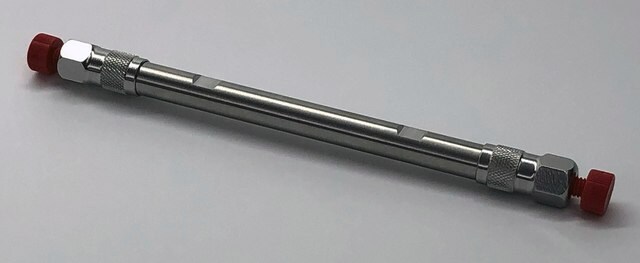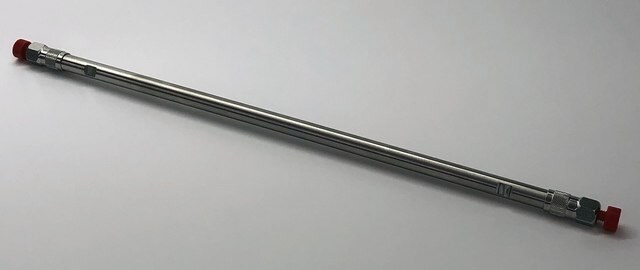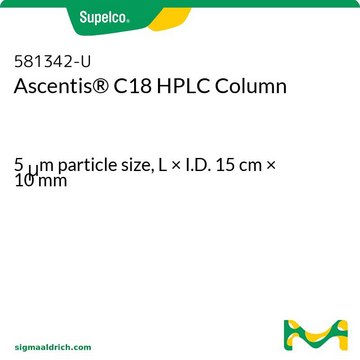581324-U
Ascentis® C18 (5 µm) HPLC Columns
L × I.D. 15 cm × 4.6 mm, HPLC Column
Sinonimo/i:
Ascentis RP18 HPLC Column
About This Item
Prodotti consigliati
product name
Colonna per HPLC Ascentis® C18, 5 μm particle size, L × I.D. 15 cm × 4.6 mm
Materiali
stainless steel column
Livello qualitativo
agenzia
suitable for USP L1 (Similar to Phenomenex Luna C18)
Nome Commerciale
Ascentis®
Caratteristiche
endcapped
Produttore/marchio commerciale
Ascentis®
Confezionamento
1 ea of
Grado di funzionalizzazione
25% Carbon loading
Parametri
≤70 °C temp. range
400 bar pressure (5801 psi)
tecniche
HPLC: suitable
LC/MS: suitable
Lungh. × D.I.
15 cm × 4.6 mm
Area superficiale
450 m2/g
Copertura della superficie
3.7 μmol/m2
Impurezze
<5 ppm metals
Matrice
fully porous particle
silica gel high purity, spherical
Gruppo funzionale matrice
C18 (octadecyl) phase
Dimensione particelle
5 μm
Dimensione pori
100 Å
operating pH range
2-8
applicazioni
food and beverages
Tecnica di separazione
reversed phase
Cerchi prodotti simili? Visita Guida al confronto tra prodotti
Categorie correlate
Descrizione generale
Ascentis C18 è una colonna HPLC di prima scelta estremamente stabile e affidabile che fornisce una forma a picchi simmetrici e un′ottima ritenzione anche con composti difficili.
Applicazioni
- Preparation of polar embedded C18 stationary phase for efficient separation of peptides and proteins in high performance liquid chromatography.: This study details the development of a polar embedded C18 stationary phase, demonstrating its effectiveness in separating peptides and proteins. The Ascentis® C18 HPLC Column was utilized for its high separation efficiency, crucial for proteomics and biopharmaceutical applications (Ali et al., 2022).
- A dilute-and-shoot liquid chromatography-tandem mass spectrometry method for urinary 18-hydroxycortisol quantification and its application in establishing reference intervals.: Researchers used the Ascentis® C18 HPLC Column to develop a sensitive method for quantifying urinary 18-hydroxycortisol. This method aids in clinical diagnostics and endocrinological studies by providing accurate reference intervals (Zhao et al., 2022).
- A Comparative Study on Analysis of Ginsenosides in American Ginseng Root Residue by HPLC-DAD-ESI-MS and UPLC-HRMS-MS/MS.: This comparative analysis utilized the Ascentis® C18 HPLC Column to separate and identify ginsenosides in American ginseng. The study highlights the column′s application in natural product research and quality control in the pharmaceutical industry (Hsu et al., 2022).
- Validation of a Rapid and Easy-to-Apply Method to Simultaneously Quantify Co-Loaded Dexamethasone and Melatonin PLGA Microspheres by HPLC-UV: Encapsulation Efficiency and In Vitro Release.: This research validates an HPLC method using the Ascentis® C18 Column to simultaneously quantify dexamethasone and melatonin in PLGA microspheres, offering a robust tool for drug delivery studies (Brugnera et al., 2022).
- Simultaneous determination of ivermectin, clorsulon and their related substances in an injectable finished product by a stability-indicating RP-HPLC method.: The Ascentis® C18 HPLC Column was employed to develop a stability-indicating method for analyzing ivermectin and clorsulon in pharmaceutical formulations, emphasizing its role in quality control and regulatory compliance (Padivitage et al., 2022).
Caratteristiche e vantaggi
- Ottima ritenzione
- Forma a picchi simmetrici
- Elevata riproducibilità
- Totale compatibilità LC-MS
Note legali
Applicazioni
Precolonna
Prodotti correlati
Codice della classe di stoccaggio
11 - Combustible Solids
Classe di pericolosità dell'acqua (WGK)
WGK 3
Punto d’infiammabilità (°F)
Not applicable
Punto d’infiammabilità (°C)
Not applicable
Scegli una delle versioni più recenti:
Possiedi già questo prodotto?
I documenti relativi ai prodotti acquistati recentemente sono disponibili nell’Archivio dei documenti.
I clienti hanno visto anche
Articoli
Phosphonates are a class of compounds commonly used for therapeutic applications of antiviral drugs. These compounds can be difficult to analyze due to their highly polar nature and lack of UV active chromophores.
Protocolli
Because reversed-phase HPLC is primarily dependent on hydrophobic interactions between the stationary phase and analyte, ion pairing is occasionally necessary to obtain sufficient retention of polar, ionizable compounds.
Separation of Phenylacetic acid
Separation of Phenoxymethylpenicillinic acid
HPLC Analysis of Warfarin™ Anticoagulant on Ascentis® C18
Chromatograms
application for HPLCapplication for HPLCapplication for HPLCapplication for HPLCIl team dei nostri ricercatori vanta grande esperienza in tutte le aree della ricerca quali Life Science, scienza dei materiali, sintesi chimica, cromatografia, discipline analitiche, ecc..
Contatta l'Assistenza Tecnica.









